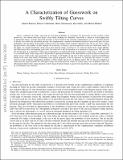| dc.contributor.author | Beirami, Ahmad | |
| dc.contributor.author | Calderbank, Robert | |
| dc.contributor.author | Christiansen, Mark M | |
| dc.contributor.author | Duffy, Ken R | |
| dc.contributor.author | Medard, Muriel | |
| dc.date.accessioned | 2021-10-27T20:29:39Z | |
| dc.date.available | 2021-10-27T20:29:39Z | |
| dc.date.issued | 2019 | |
| dc.identifier.uri | https://hdl.handle.net/1721.1/135856 | |
| dc.description.abstract | © 1963-2012 IEEE. Given a collection of strings, each with an associated probability of occurrence, the guesswork of each of them is their position in a list ordered from most likely to least likely, breaking ties arbitrarily. The guesswork is central to several applications in information theory: average guesswork provides a lower bound on the expected computational cost of a sequential decoder to decode successfully the transmitted message; the complementary cumulative distribution function of guesswork gives the error probability in list decoding; the logarithm of guesswork is the number of bits needed in optimal lossless one-to-one source coding; and the guesswork is the number of trials required of an adversary to breach a password protected system in a brute-force attack. In this paper, we consider memoryless string sources that generate strings consisting of independent and identically distributed characters drawn from a finite alphabet, and characterize their corresponding guesswork. Our main tool is the tilt operation on a memoryless string source. We show that the tilt operation on a memoryless string source parametrizes an exponential family of memoryless string sources, which we refer to as the tilted family of the string source. We provide an operational meaning to the tilted families by proving that two memoryless string sources result in the same guesswork on all strings of all lengths if and only if their respective categorical distributions belong to the same tilted family. Establishing some general properties of the tilt operation, we generalize the notions of weakly typical set and asymptotic equipartition property to tilted weakly typical sets of different orders. We use this new definition to characterize the large deviations for all atypical strings and characterize the volume of tilted weakly typical sets of different orders. We subsequently build on this characterization to prove large deviation bounds on guesswork and provide an accurate approximation of its probability mass function. | |
| dc.language.iso | en | |
| dc.publisher | Institute of Electrical and Electronics Engineers (IEEE) | |
| dc.relation.isversionof | 10.1109/TIT.2018.2879477 | |
| dc.rights | Creative Commons Attribution-Noncommercial-Share Alike | |
| dc.rights.uri | http://creativecommons.org/licenses/by-nc-sa/4.0/ | |
| dc.source | arXiv | |
| dc.title | A Characterization of Guesswork on Swiftly Tilting Curves | |
| dc.type | Article | |
| dc.contributor.department | Massachusetts Institute of Technology. Research Laboratory of Electronics | |
| dc.relation.journal | IEEE Transactions on Information Theory | |
| dc.eprint.version | Author's final manuscript | |
| dc.type.uri | http://purl.org/eprint/type/JournalArticle | |
| eprint.status | http://purl.org/eprint/status/PeerReviewed | |
| dc.date.updated | 2019-06-21T12:25:05Z | |
| dspace.orderedauthors | Beirami, A; Calderbank, R; Christiansen, MM; Duffy, KR; Medard, M | |
| dspace.date.submission | 2019-06-21T12:25:07Z | |
| mit.journal.volume | 65 | |
| mit.journal.issue | 5 | |
| mit.metadata.status | Authority Work and Publication Information Needed | |
